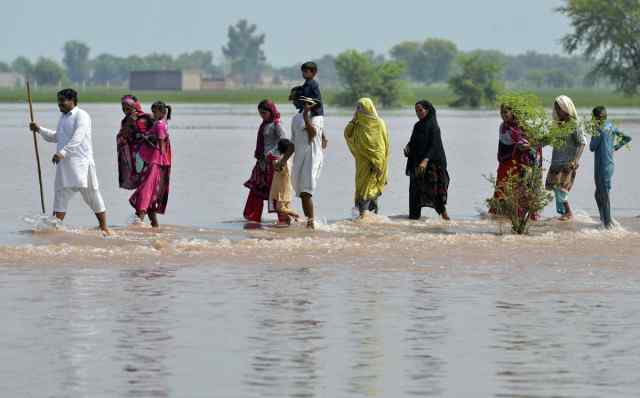Lahore — Rising waters in the Indus River have forced thousands of families across South Punjab to abandon their homes, as relentless monsoon rains batter the province. Villages in Layyah, Taunsa, Dera Ghazi Khan, Rajanpur, and Muzaffargarh are among the hardest hit, with protective embankments collapsing and floodwaters swallowing entire settlements.
Homes and Crops Swept Away
In Layyah and Taunsa, dozens of villages — including Sumra Nashaib, Lohanch Nashaib, Mirani Paka, and Kotla Miran — are now under water. Earthen houses have collapsed, farmland lies submerged, and families are left clinging to what little they could carry. Livestock, often a household’s only source of income, is being moved to higher ground in desperate attempts to keep it alive.
In Muzaffargarh, breaches in embankments have worsened the crisis. A 15-foot-wide break in a protective bund near Tehsil Jatoi forced the evacuation of Laskani and Kehal villages. Locals say they had no support from the authorities and filled the gaps with their own hands in a race against the rising floodwaters.
Alipur tehsil is facing a similar ordeal. Cotton, sesame, and mung bean crops — critical to local livelihoods — have been destroyed across vast tracts of farmland. A villager from Bait Dewan, Wazir Khan Gopang, reported losing nearly 30 acres of crops overnight. “The government did nothing to protect us,” he said, adding that his family had been forced to flee with their livestock.
Emergency Warnings Across Punjab
The Provincial Disaster Management Authority (PDMA) has issued a red alert as rivers swell and major dams approach full capacity. With heavy rains forecast until at least August 24, district administrations have been told to remain on high alert.
In the past day alone, Narowal saw nearly 94mm of rain, with significant downpours also reported in Sargodha, Sheikhupura, Faisalabad, Lahore, and Rawalpindi. Officials warn that more cloudbursts in the upper regions could worsen flooding in the coming days.
According to PDMA Director General Irfan Ali Kathia, this monsoon spell is proving “more intense” than previous ones, and all local governments have been ordered to step up preventive measures. Relief agencies have been instructed to stay active in flood-hit zones, while residents are being urged to avoid rivers, drains, and low-lying areas.
Rivers and Dams Under Pressure
The Indus is currently at medium-level flood at Taunsa and Chashma, while Tarbela and Kalabagh are experiencing lower but rising levels. Meanwhile, the Sutlej River is also swelling at Ganda Singh Wala and Sulemanki.
Water storage has reached critical thresholds: Tarbela Dam is already 98% full, and Mangla stands at 74%. Indian dams are also nearing 70% capacity, raising concerns about further surges downstream into Pakistani rivers including the Jhelum, Chenab, Ravi, and Sutlej.
A Region on Edge
With homes reduced to rubble and farmland drowned, South Punjab faces both immediate displacement and longer-term economic hardship. The destruction of cash crops like cotton and sesame — cornerstones of the local economy — is likely to deepen financial distress in the months to come.
For now, thousands remain stranded or displaced, waiting for relief operations to reach them. The next few days of rain may determine whether the crisis worsens or begins to ease.
